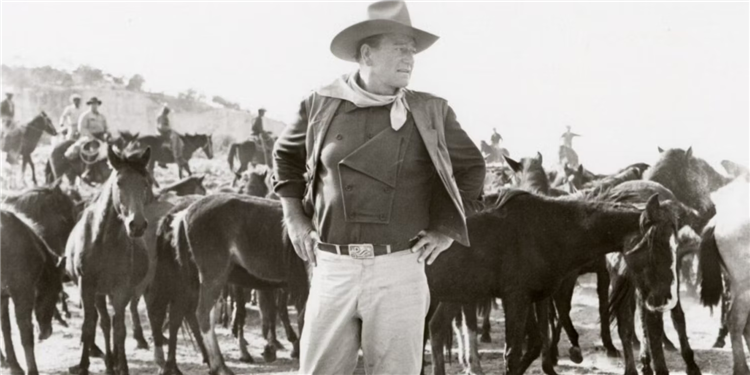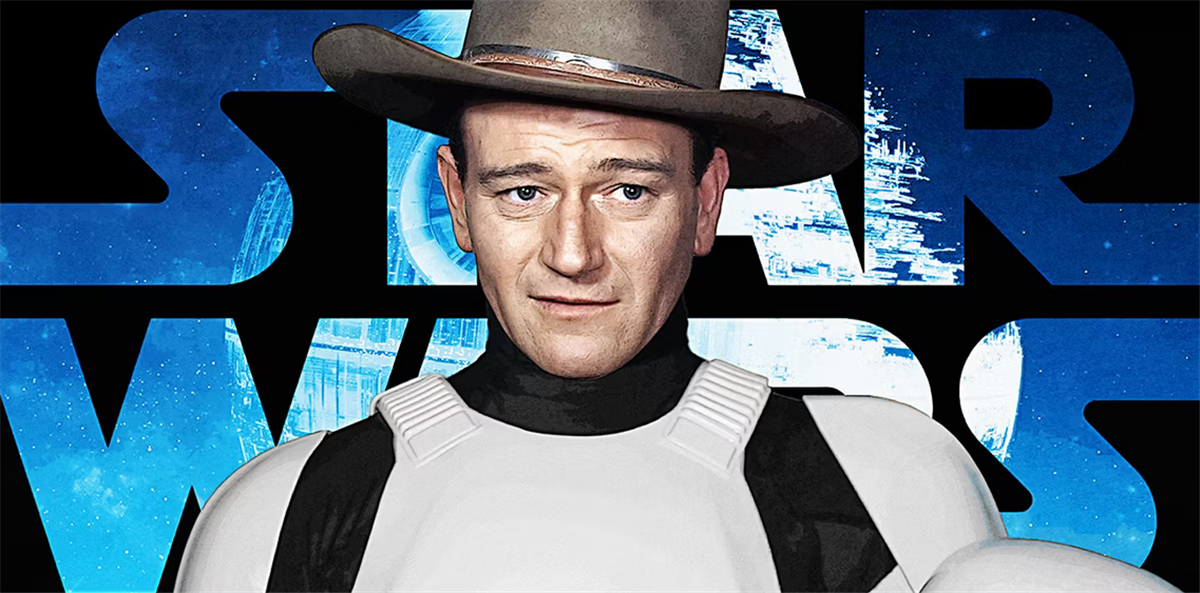How does the iconic cowboy fit in a galaxy far, far away?
It’s no secret to anyone how John Wayne influenced the original Star Wars. Just look at the whole Wild West vibe in Tatooine and other Outer Rim planets, or the way Harrison Ford imprinted an aura of cowboy coolness in Han Solo, and his dynamics with his sidekick Chewbacca (Peter Mayhew). Westerns have always played an important part in creating George Lucas‘ galaxy far, far away, and remain so even today, with series like The Mandalorian and The Book of Boba Fett still attempting to emulate the same spirit as Wayne’s classic movies.
But what’s even cooler about Wayne’s relationship with Star Wars is that it goes way beyond mere inspiration and influence, and he and his legacy play an important role in the franchise to this day. Many scenes in A New Hope were modeled after moments in Wayne’s classic The Searchers, like Luke Skywalker (Mark Hamill) arriving at the Lars Homestead to find it in flames, and, later, in Attack of the Clones, Anakin Skywalker (Hayden Christensen) kills a whole Tusken Raider tribe much like the Comanche camp battle in Wayne’s classic Western. And while many may think John Wayne himself was never in Star Wars, that’s not quite true — from a certain point of view, of course.
The Duke Has a Secret Cameo in the Original ‘Star Wars’

How can you think of a desert planet and not populate it with Western-inspired lore? Well, Star Wars goes a little beyond that, really, as the Duke has a blink-and-you’ll-miss-it cameo in A New Hope, something revealed by legendary sound engineer Ben Burtt himself a few years back, in Star Wars Celebration IV in 2007.
Burtt needs no introduction to Star Wars fans, but we’ll cut everyone else some slack: he’s the genius behind every iconic sound in the franchise under Lucas’ command. From Chewbacca’s roar to R2-D2’s (Kenny Baker) beeping, from blaster shots to lightsaber humming and, of course, Darth Vader’s (James Earl Jones) breathing — it’s all him. And John Wayne’s part was only possible because of him, too. Wayne voices Garindan, a Kubaz spy in Tatooine’s Docking Bay 94. Okay, but who’s Garindan, and what’s a Kubaz? The character itself is an insectoid alien that looks like a hooded mosquito. He’s working for the Empire and tips them on the whereabouts of Luke Skywalker, Obi-Wan Kenobi (Alec Guinness), C-3PO (Anthony Daniels), and R2-D2. If you’re still having trouble, think of The Mandalorian, and its very first episode: the alien who calls the cab for Mando (Pedro Pascal) and the Mythrol (Horatio Sanz) by playing a flute. That’s a Kubaz, and Garindan looks like that.

The realization came when Burtt was working on Attack of the Clones, looking for inspiration for the voice of Poggle the Lesser (Matthew Wood), who’s an insectoid. The only other insectoid character before him was Garindan, and Burtt remembered how he did it by going through his notes at that time: “I discovered it was an electronic buzzing which had come off of my synthesizer that was triggered by a human voice. And I listened to it and realized it was John Wayne — I had found some loop lines in the trash from the studio that had been thrown away. So the buzzing was triggered by some dialog like ‘All right, what are you doing in this town’ or something like that.”
As Burtt revealed this information only in 2007, it’s likely that Wayne never knew about his part in A New Hope. He died in 1979, two years after the movie came out. Officially, his last role was in The Shootist, which came out a year before the original Star Wars. He’s uncredited for Garindan’s voice in the movie, but that’s also not his last contribution to the franchise…
The Wayne Legacy Continues in ‘The Mandalorian’

While John Wayne’s avatar in Star Wars may indeed be Han Solo, recently another character arose with the same principle. Anyone who has ever watched The Mandalorian can see how the main character is based on multiple Western heroes, and John Wayne is one of those. But it goes way beyond that, actually, as there’s an actual member of his family under the armor. While Mando is voiced and generally credited to Pedro Pascal, it’s Brendan Wayne, John’s grandson, who we see most of the time.
Mando is a rather complex character, so it takes three people to properly portray him. Pascal is in extremely high demand in Hollywood, so he shares the role with Brendan Wayne and Lateef Crowder. Each of them brings a different aspect of the single character we know as Din Djarin, and those three performances are complimentary to one another. Pascal is his voice and face, while Brendan Wayne is the one who handles guns and weapons and Crowder takes over for fight scenes.
In a recent interview with Vulture, Brendan revealed that much of his work as Din Djarin is based on his grandfather’s iconic presence. Whenever we see John Wayne on-screen, we can’t help but notice his signature posing, from the way he walks to how he stands. According to Brendan, that’s all because, while he was a very strong man, he had tiny feet. “So he walked on his toes, like a dancer,” he says. He picked that up for his own portrayal of Din, who’s really a space gunslinger at heart.
For Seasons 1 and 2 of The Mandalorian, Din Djarin’s character was credited only to Pedro Pascal, but that changed for Season 3. Brendan and Lateef finally have their names up there along with Pascal’s in the credits for the episodes, and it’s about time! A bounty hunter by trade, Mando has those three sides of his character very active all the time, so each of the actors brings a very important contribution to the part. Still, since guns are his main way of doing business, Brendan is the one who spends the most time with the helmet on. Luckily for us, a beskar helmet fits him just as right as a cowboy hat did his grandfather.
